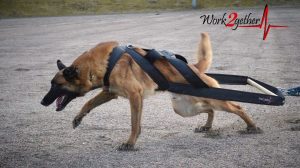
Although Weight pulling has been in existence for decades, it has become controversial recently as animal welfare activists condemn the sport as cruel. They claim that dogs who participate in weight pulling do so against their will and that they are at risk of severe injury.
Weight pulling fanciers on the other hand claim that although elite pulling dogs may pull several dozen times their own weight, the risk of injury is very low thanks to great conditioning and also a genetic predisposition to pulling heavy weight. In this blog post we are going to review the 3 benefits of safe weight pulling and put to bed the myths surrounding this excellent sport and conditioning activity.

Benefit 1: Strengthens the Owner-Dog Bond
It’s no secret that dogs crave the company of their handler. The more time you spend with your dog, the happier they are. Dogs originally evolved through the bond created between the ancient wolf and hunter gatherer. This was a bond built on co-operation based on daily activity of scavenging, hunting and protecting. Therefore, hard wired in your dog is a natural desire to be out active with their handler. Weight pulling gives a perfect opportunity to do this as it requires team work and trust to achieve a successful pull!

benefit 2: IMPROVES you’re dogs BEHAVIOR
According to the American Pulling Dogs Association (APDA), weight pulling helps improve many behavioral issues in dogs too including:
- Excessive aggression
- Hyperactive barking
- Complacent Chewing ( furniture, shoes etc)
- Nervousness
- Shyness
- Obsessive compulsive behavior (spinning, tail chasing, fence running, self-mutilation, hallucinating (fly biting), circling, hair/air biting.)
- Pacing

Benefit 3: builds Lean Muscle
When it comes to increasing canine muscle mass, weight pulling is one of the most effective activities you can do. The reason being is it takes strength and power to move the weight. Consistent weight pulling develops your dogs type II muscle fibres and phopspocreatine energy system which are responsible for building lean muscles.
Other exercises—such as running, jogging, and swimming—are mainly cardiovascular endurance activities. They give your dog a solid workout, but they don’t stimulate growth of your dogs muscles.
Also weight-pulling is one of the few dog exercises that allow you to manually increased the progressive overload (adding more resistance over time). Once your dog is comfortable to pull a specific amount of weight, you can then increase the weight slowly which automatically generates new muscle growth and builds a stronger dog with leaner harder muscle.
5 tips to start weight pull
If you are interested in starting weight pulling, either competitively or recreationally, the following guidelines will help you:
- Start with a light weight to improve your dog’s conditioning over time gradually
- Give your dog a 5 – 10 minute break between each pull
- Keep your dog hydrated.
- Use a harness that is tailored for your dog’s specific size. Harnesses that are too small or too large can lead to an injury. For large dogs we recommend our Large Dog Weight Pull harness. For small to medium breeds we recommend our Heavy Duty Sporting Harness
- Always end your training sessions on a positive note

Finally, for best results, claim your personalised weight pull plan via our 12 Week Conditioning program. From nutrition to exercise it will fast track your dogs performance and success.
Keep Them Fit!
P.S.
Check out our top 3 most popular conditioning tools right now